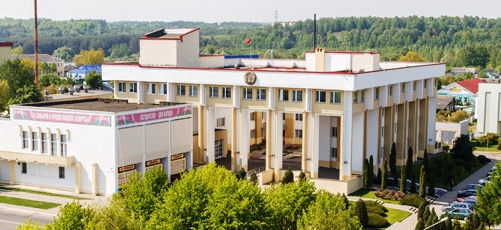Region
Geography
The Shklov region is located to the north of the Mogilev oblast. The total area is 1,334 square kilometers. The region stretches for 52 km from east to west and for 38 km from north to south. It borders on the Gorki, Dribin, Mogilev, Krygloe, Belynichi regions of the Mogilev oblast and the Tolochin and Orsha regions of the Vitebsk oblast.
There are 12 rural councils and one town in the region.
Crossing the region is the river Dnepr with its 31 smaller inflows.
 Heraldry
Heraldry
The region’s emblem featuring scales bears testimony to Shklov’s past as a great trading center.
Population
The region’s population is 35,500 people, of them 15,900 live in the town of Shklov and 19,600 people live in 206 villages.
History
The Shklov region has a lot of archeological and architectural monuments which testify to its rich and colorful history.
The region was first mentioned in chronicles in the early 16th century. Due to its geographic position the region was repeatedly invaded by the neighboring countries. In 1535 it served as a battlefield for Russian and Polish armies and in 1708 - for Polish and Lithuanian armies. In 1580, the town of Shklov was burned down. It was then rebuilt at its present-day location.
In 1762, the town was given the right to found a magistrate and an emblem featuring the scales which bears testimony to the town’s long-standing trading traditions. The town also had its seal which had been in use since 1767.
In 1769, a disastrous fire swept through the town destroying 300 houses. As a result new blocks of buildings appeared in the redeveloped Shklov. The most picturesque place of the renovated town was the main square with the magnificent town hall tower in the middle. There were also a market, a post office, a church, a monastery and a school in the square. Now the restored building of the ancient town hall houses a gymnasium.
In the late 18th century, the town became center of uyezd of the Mogilev province of the Russian Empire. In 1773, Ekaterina II gave Shklov to Prince Potemkin. In 1778, Ekaterina II gave some villages of Shklov County to Semen Zorich who started developing trade and local folklore. In 1780, Semen Zorich opened a cadet corps in Shklov which was relocated first to Grodno, then to Smolensk and Moscow where it was named the First Cadet Corps. In the late 19th century, the Shklov estate became property of the minister of communications of the Russian Empire Appolon Krivoshein. It is noteworthy that all the owners of Shklov fostered development of manufacture.
A theater, a building for the cadet corps, silk, wool and rope manufactures built in the late 18th century did not survive. Only town hall and an Orthodox Church made it through to our days.
Shklov became an administration center of the Shklov region on July 17, 1924. Today Shklov is a nice modern town.
In 1898, Appolon Krivoshein built a cardboard factory in Shklov which specialised in production of cardboard and packaging paper. In 1908, the factory launched the production of paper. Gradually it turned into a leading paper manufacture of the Russian Empire. Today it is a paper factory Spartak. A Linen Mill and a Butter Factory have been working in the region since 1931 and 1935 respectively.
One of peculiar sites of the region is a tourist and leisure compound Lysaya Gora (Bold Mountain) built following the examples of old Slavic wooden architecture. The compound features comfortable guest houses, a restaurant and a shop.
The Shklov region was home to Josef Guzikov, the inventor of xylophone; Klim Mikhailov, a famous carpenter who took part in making an iconostasis of Smolensk Cathedral of Novodevichy Convent in Moscow; film actor Piotr Aleinikov, Professor Ivan Voronkov, Alexei Polyakov.











